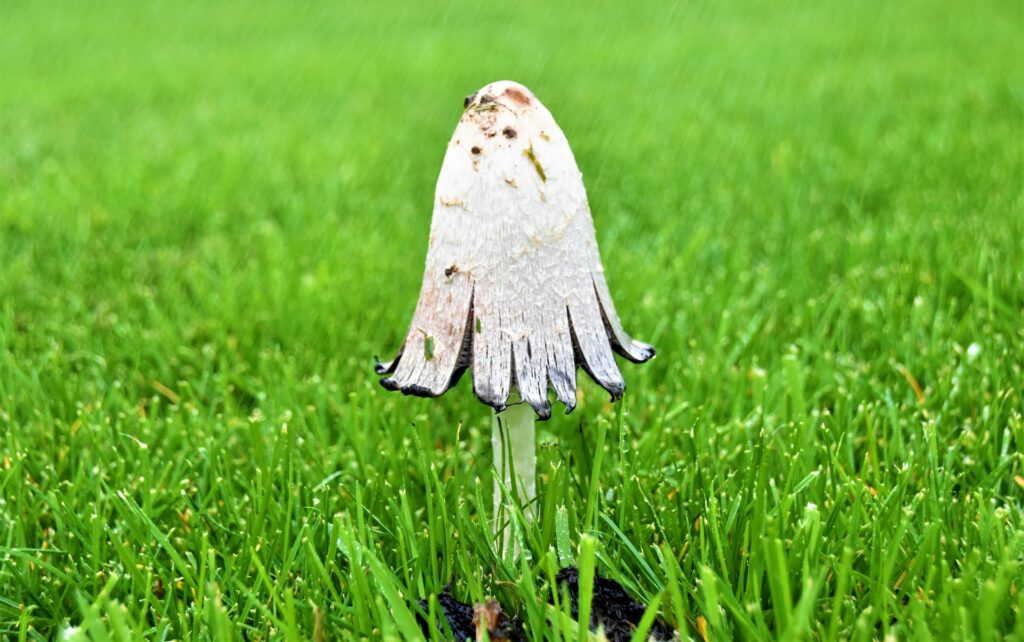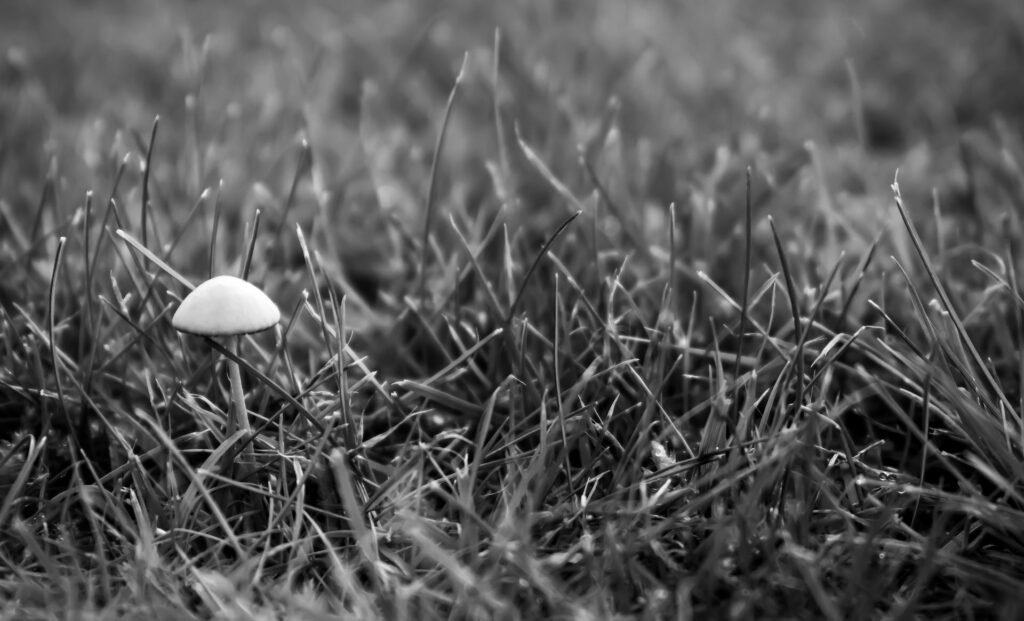Why are Mushrooms Growing in my Yard?
Your yard could become a mushroom wonderland! Air bourne fungal spores seek out areas with plenty of nutrients, shelter from the sunlight and moisture to establish themselves as your new fungi friends – all you need is a bit of decomposing matter for them to thrive.
Autumn in your garden can offer the perfect environment for a variety of mushrooms to take root. Excess growth, leaf fall and grass clippings all make prime real estate for fungi spores to settle into!
Mushroom Ecology
Mushrooms may appear to be pesky, but they are actually nature’s way of enriching your soil! These fungi break down organic matter and transform it into essential nutrients for the wellbeing of other plants in your lawn. So keep an eye out–if you see mushrooms popping up, that means there is some happy nutrient-rich activity going on beneath the surface!
A wild, overgrown yard can harbor a veritable feast for its fungal inhabitants! Animal waste, dead grass and leaves, branches… even decomposing tree trunks or roots offer an abundance of nutrition to mushrooms that helps other plants survive.
Yards with inadequate drainage and an abundance of shadows are perfect conditions for fungi to flourish. Additionally, thick thatch can be hazardous – not only does it hold in excessive moisture, but delivers nutrient-rich organic matter over time which serves as additional fuel for funguses.
Yards can provide a setup for the perfect mushroom party! Animals like dogs, cats, chickens and goats all help contribute to organic matter that mushrooms need in order to grow. With this cozy atmosphere already existing from pet waste, mushrooms will be sure to sprout up no time at all!
How Do Mushrooms Reproduce and Spread
There’s a truly remarkable way that mushrooms spread their spores – they create the perfect environment for them to take flight! Through evaporation, these fungi are able to generate cool air and water vapor around themselves. This creates enough lift for the reproductive cells of the mushroom (spores) to be carried up as many as four inches away from its source – an incredible feat given how small they can be! UCLA researcher Marcus Roper has studied this phenomenon in depth, revealing more about these amazing organisms’ ability at dispersal.
Even in times of hardship, nature finds a way to survive and flourish: mushrooms can lie dormant until the right conditions arise for them to bloom into new colonies.
How Fast Do Mushrooms Grow
Your garden can be abuzz with activity as mushrooms sprout in a matter of days! While some may reach maturity within just 24 hours, others might take up to 4 days depending on the prevailing conditions like moisture and temperature. No sooner have you planted them than they’re ready for harvest, so get gardening today!
How To Get Rid Of Mushrooms in Lawns
Proactive prevention is the key for a healthy lawn free of mushrooms. Follow these simple tips to keep your grass green and vibrant – no mushroom worries needed!

6 Tactics To Get Rid of Mushrooms:
- Improve Lawn Drainage mushrooms flourish in moist conditions. Improve drainage by aerating your lawn and if necessary amend the soil with sand
- Dethatch Your Lawn and mowing it short will improve airflow and light penetration to the soil, also removing excess moisture
- Clear Organic Materials such as grass clippings, fallen leaves, and other items that can increase moisture build-up and damp
- Only Water Early Morning avoid watering your lawn in the afternoon or evening as this creates the perfect damp environment overnight for spores to become active
- Apply High Nitrogen Fertilizer this will speed up the decomposition of the organic matter that mushrooms feed on, shortening their lifespan
- Apply Fungicide Treatment to your lawn, this will penetrate into your soil and tackle dormant mushroom spores sitting within the soil
To ensure your lawn remains fungi-free like a palace, tackle the problem now and take proactive measures in the future. Rid mushrooms from your area of paradise with one simple fungicidal treatment to keep it looking pristine!
How To Kill Mushrooms Using Fungicide
Mushrooms may look like delicate and delicious fruit, but they are actually an intriguing part of a hidden kingdom growing beneath our feet. These mushrooms are just the tip of the fungi iceberg – to really solve your problem you must take drastic measures belowground by spraying fungicide onto the source itself.
Fungicide
Combat your lawn’s fungal foes quickly and easily with garden fungicides! Complete the job safely by outfitting a sprayer attachment to your hose, diluting product for use in backpack or pump sprays, or sprinkling granular products across affected areas. All are ideal solutions where children and pets play – giving you peace of mind when protecting what matters most.
With some effort, you can control the current mushroom problem – but don’t let your guard down. To completely banish them from returning and spoiling future plans, added preventive measures must be utilized in order to achieve long-term success.
Pick and dispose of any visible mushrooms so they do not spread spores and clean your lawn areas of any decaying matter that could contribute to mushroom growth.
If typical household products don’t seem to do the trick, why not call in a pro? They have access to more powerful treatments that can really get your lawn looking its best!
Natural Ways To Remove Mushrooms On Lawns
The most efficient way to get rid of mushrooms is to simply observe their life’s journey, allowing them slowly fade away as fate unfolds.
Mushrooms may seem like they magically appear in our gardens, but it’s quite the opposite! Mushrooms actually feed off of decaying organic material and with its absence they will quickly go away. To ensure a healthy garden free of mushrooms remove any potential sources such as stumps, tree branches, animal waste or grass clippings. And don’t forget to regularly rake your thatch for complete mushroom removal – then watch them vanish before your eyes!
Vinegar
Get rid of pesky mushrooms in your yard with a natural, vinegar-based solution! Though typical household and cooking vinegars are too diluted for the job, horticultural varieties boast an impressive 30-50% concentration to help you get maximum results.
Transform regular household vinegar into a powerful gardening solution with just the right blend of 4 parts water and 1 part horticultural vinegar. Store it in an easy-to-use spray bottle for spot treatment – but before you get started, be sure to don your protective eyewear and gloves as this strong mixture can cause some serious skin irritation.
Avoid your yard looking like a mushroom graveyard – spritz the pesky fungi with vinegar and watch them die! Be mindful of any nearby grass, though; it’s best to check its reaction first by spraying on an experimental patch for a few days.
How Does Vinegar Kill Mushrooms
Vinegar is a valuable ingredient that not only adds flavour to foods, but also provides medical benefits. It’s famed acetic acid has the power to kill bacteria and fungi infections – making it an essential part of our medicine cabinets!
Baking Soda
Instead of using harsh chemicals, baking soda offers a gentler approach to getting rid of mushrooms in your soil. Raising the pH with this natural product can inhibit mushroom growth without causing harm to other plants or animals that may be around it. It’s an effective and safe solution – although not permanent – for tackling pesky fungi!
Give your mushrooms the relief they need with a simple baking soda solution! Mix two tablespoons of baking soda into one gallon of water and stir until dissolved, then spray onto those pesky fungi. This easy concoction will help to stop mushroom growth over time – no more sprouting ‘shrooms in that same spot for you!
To control mushroom growth in your garden, try sprinkling baking soda! This inexpensive and safe method may need to be repeated regularly for full effectiveness – but it provides an ideal solution if you have children or pets.
How Does Baking Soda Kill Mushrooms
Baking soda acts as a shield against unwelcome fungi in your garden – its sodium bicarbonate content degrades the growth of mushrooms and wards off their presence. Cleverly prevent potential problems ahead with this natural, environment-friendly solution!
Dish Soap
An effortless, natural way to combat mushrooms is using dish soap. It’s an easy alternative for those looking for a simple solution!
To rid your garden of pesky mushrooms, mix a spoonful or two of dish soap with up to three gallons of water. Then take a screwdriver and puncture the soil around them – this will allow you to pour over soapy goodness that’ll cut off their lifecycle at its root!
Reduce unwanted mushrooms quickly and easily with a simple trick – just water your soil daily with soapy water. With regular applications, you’ll soon see the mushroom colonies diminish; all it takes is a little extra effort to make sure the soap penetrates deep into their habitat!
Getting Rid Of Mushrooms In Yard Areas
- Keep It Clean Remove dead grass clippings, leaves, and any other decaying organic material. If left in the yard it is the perfect food source for mushrooms to flourish.
- Control Moisture Water your yard sparingly. The best time to water the lawn is early in the morning so that the sun has time to dry off any extra moisture.
- Lift Mushrooms By Hand Wear gloves to pick mushrooms and put them in the trash. Do not put them into a compost pile or their spores will spread.
- Apply Nitrogen Fertilizer This will increase the speed organic matter in your soil decays. This will accelerate the life cycle of the mushrooms, killing them off quicker.
Do mushrooms Grow Back After You Pick Them?
‘Tis a miracle of nature! The mushroom you just plucked may seem like it’s gone forever, but never fear; its network of underground mycelium can regenerate new fungi in the blink of an eye. All that stands between you and another bounty is to leave the area untouched – no fungicides needed here!
Are Mushrooms In My Lawn Dangerous
The mushrooms in your yard may seem like a nuisance, but they are actually performing an important task! They act as nature’s recyclers by breaking down organic matter into beneficial nutrients that help nourish the soil and contribute to healthy grass growth.
Enjoy the natural beauty of mushrooms without worry; they’ll consume decaying matter and then promptly disappear, leaving your yard disease-free.
When traversing the outdoors, it is important to know that not all mushrooms are edible – in fact, there over 100 species of toxic fungi lurking out there. Eating them can cause a slew of issues ranging from an upset stomach and nausea to kidney failure. In some cases they may even be fatal if left untreated!
Harvard University has identified the Death Cap mushroom as one of nature’s most lethal creations – its poison can be fatal if consumed.
While they may seem like a tasty treat, these mushrooms can be deceiving. Appearing almost identical to the edible ones we buy from our local supermarkets, it is important that you exercise caution when venturing into unknown terrain full of fungus!
Eating wild mushrooms is a dangerous gamble: with the difficulty of identification, one bite could be your last. Don’t risk it – stick to store-bought for safe and reliable mushroom consumption!
After ingesting potentially poisonous mushrooms, a person can experience an unfortunate double-whammy of symptoms. Initially there may be mild digestive discomfort followed by a short lull where the individual believes they are recovering; however in several hours or days it could quickly escalate to septic shock, internal bleeding and liver failure – for which there currently is no known antidote.
It’s important to work together as a family to ensure your children don’t come into contact with mushrooms they may find growing in the wild. If you have any suspicion that one of them has eaten something, seek medical care right away; take the mushroom if possible so experts can make an informed decision about treatment.
Verdict: How To Get Rid Of Mushrooms In Lawns
Mushrooms may look beautiful in a fairy tale, but they can be an unwelcome guest on your property. Not only are mushrooms aesthetically displeasing to the eye, some varieties contain toxins which could lead to serious health issues if ingested by people and pets – making them more than just pesky decoration. Eliminate these fungi with caution for everyone’s safety!
Combat mushroom invasions in your yard with a three-pronged strategy! Start by removing any visible mushrooms as quickly as possible to reduce their output of spores. Then, address what’s allowing them to grow – is there excessive moisture or shade? Finally, take action against the remaining fungi with natural solutions such as vinegar and baking soda or chemical treatments for long-term prevention.
Read more: Kentucky bluegrass vs tall fescue





